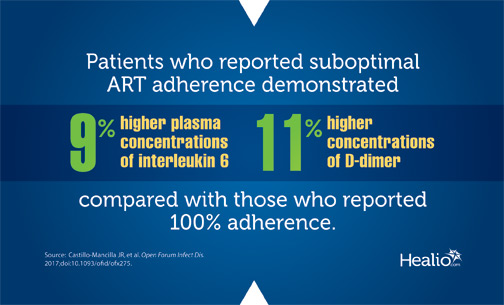Suboptimal ART adherence associated with greater inflammation in patients with HIV
Recently published findings indicate that suboptimal adherence to ART is associated with activation of coagulation and enhanced residual inflammation among patients with HIV, even if patients have already achieved virologic suppression.

“As modern antiretroviral drugs have become more potent and forgiving to missed doses, it has become easier to achieve and sustain viral suppression (by conventional assays) without the need for perfect adherence,” Jose R. Castillo-Mancilla, MD, associate professor of medicine at the University of Colorado Anschutz Medical Campus, told Infectious Disease News. “Our findings stress the importance of striving to the highest possible adherence to achieve the maximal benefit of antiretroviral therapy as it pertains to chronic residual inflammation and coagulopathy.”
The researchers performed a retrospective analysis of patients enrolled in the Strategies for Management of ART (SMART) study, a multinational, randomized clinical trial of 5,472 patients with HIV aged 13 years and older. All patients were receiving ART, had completed a questionnaire about adherence and had available measurements of viral load. The analysis focused on patients who were virally suppressed (n = 3,056), with viral loads of less than 200 copies/mL.
Patients who reported suboptimal adherence (< 100%) had 9% higher plasma concentrations of interleukin 6 compared with those who reported 100% adherence (95% CI, 1%-18%), the researchers reported. Similarly, those with suboptimal ART adherence demonstrated 11% higher concentrations of D-dimer (95% CI, 1%-22%).
“We demonstrated that suboptimal ART adherence, even if it results in virologic suppression by conventional clinical assays, is associated with enhanced residual inflammation and activation of coagulation in PLWH on chronic ART,” the researchers wrote. “These findings replicate previous cohort observations and highlight the importance of optimal and durable ART adherence as a potential factor to improve morbidity and mortality in HIV disease.” – by Andy Polhamus
Disclosures: Castillo-Mancilla reports no relevant financial disclosures. One researcher received speaking fees for two presentations in 2015.

